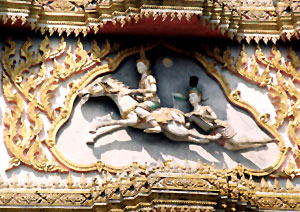 Channa was the head charioteer and royal servant of Gautama . He was instrumental in bringing the prince face to face with reality. King Suddhodana was given the responsibility of looking after the needs of the prince. At an early age it was predicted by sage Asita that Siddhartha would renounce the worldly pleasures to become an ascetic. Hence he had been pampered with all kinds of luxury to abstain him from knowing about the pain and suffering that exists in the world. The Dhammapada conveys that Channa later achieved arhanthood.
Channa was the head charioteer and royal servant of Gautama . He was instrumental in bringing the prince face to face with reality. King Suddhodana was given the responsibility of looking after the needs of the prince. At an early age it was predicted by sage Asita that Siddhartha would renounce the worldly pleasures to become an ascetic. Hence he had been pampered with all kinds of luxury to abstain him from knowing about the pain and suffering that exists in the world. The Dhammapada conveys that Channa later achieved arhanthood.
Channa controlled the chariot, which was pulled by Kanthaka, Siddhartha`s favorite horse. It was at this time that Siddhartha saw an elderly man, a sick man, a funeral and an ascetic. This event brought major changes in Siddhartha and he decided to leave the palace and lead the life of an ascetic. Channa helped the prince to get away from the palace while the guards were sleeping. He saddled Kanthaka and guided Siddhartha to the banks of river Anoma. Though he initially refused to leave the young prince but Siddhartha convinced him to return back to the kingdom. At last Channa returned with the prince`s his weapons, accessories and hair.
When Siddhartha returned to Kapilavastu, as Buddha Channa became a Buddhist monk. He also joined the Sangha. After much toil he finally became an Arhant. The legends about Channa are quite popular and are also mentioned in various Buddhist texts that depict the early life of Buddha and his transformation from a prince to an ascetic.




















